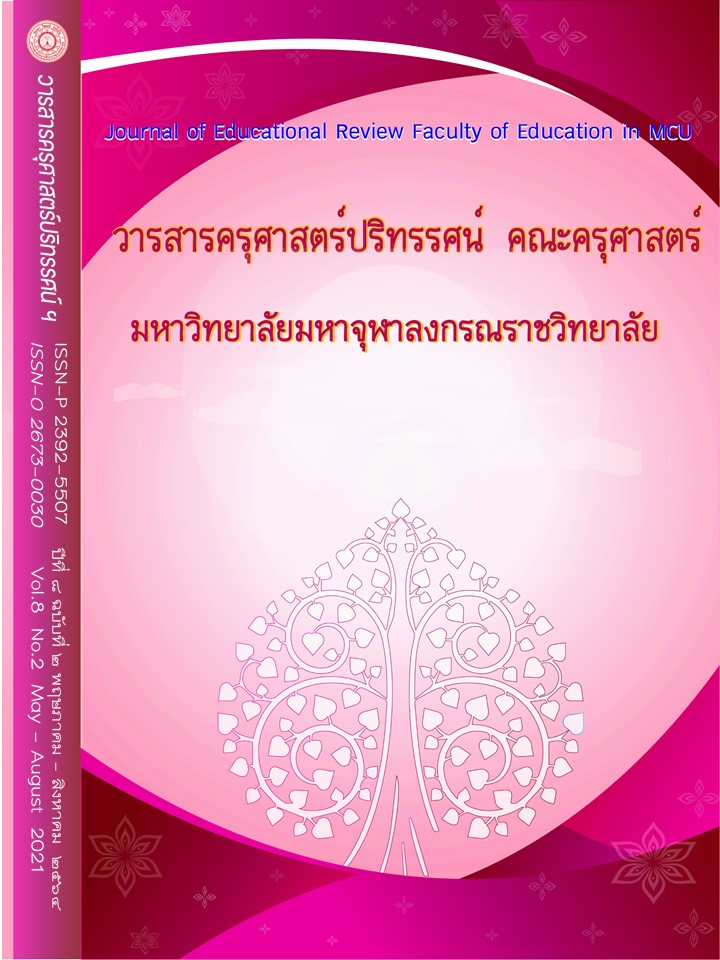MODEL KNOWLEDGE MANAGEMENT STEM EDUCATION FOR ELEMENTARY EDUCATION TRAT PRIMARY EDUCATION SERVICE AREA OFFICE
Main Article Content
Abstract
The objectives of this research paper were 1) to study the condition and guidelines for the implementation of STEM education management, 2) to develop knowledge management model of STEM education, and 3) to examine and evaluate knowledge management model of STEM education for elementary education Trat Primary Education Service Area Office. There were 3 steps of research methods. Step 1 was to study condition for the implementation of STEM education management by using questionnaires with a sample of 226 people, and studied guidelines of knowledge management in STEM education with a group of 7 key informants using interview. Step 2 was to develop the model by using in-depth interviews with 5 experts. Step 3 was to examine and evaluate the model by using an assessment form with a sample of 226 people. The statistics used to analyze the data were percentage, mean and standard deviation. Results of the research were as follows: 1) condition and guidelines for knowledge management of STEM education for elementary education in overall was at a high level of practice. When considering each aspect, it found that the practice was at a high level in all aspects, including supervision and monitoring of operations at the educational area level, development of teachers and related personnel establishing support systems and strengthening operations, and raising awareness. 2) Knowledge management model of STEM education for elementary education consisted of 3 components: Component 1 was knowledge management of STEM Education with 28 Indicators; Component 2 was process for knowledge management of STEM Education with 6 indicators; Component 3 STEM learning management with 6 indicators. 3) Results of the experiment and assessment for knowledge management model of STEM education for elementary level, Trat Primary Education Service Area Office found that results of the feasibility assessment and usefulness in bringing the pattern to be used in the overall possible and usefulness at the highest level. When considering each aspect, it found that every aspect was feasible and the usefulness was at the highest level.
Article Details
ทัศนะและความคิดเห็นที่ปรากฏในบทความในวารสารฉบับนี้ถือเป็นความรับผิดชอบของผู้เขียนบทความนั้นเพียงผู้เดียว และไม่ถือเป็นทัศนะและความรับผิดชอบของกองบรรณาธิการ
กองบรรณาธิการขอสงวนสิทธิ์ในการคัดเลือกบทความลงตีพิมพ์และจะแจ้งให้เจ้าของบทความทราบหลังจากผู้ประเมินบทความตรวจอ่านบทความแล้ว
ต้นฉบับที่ได้รับการตีพิมพ์ในวารสารครุศาสตร์ปริทรรศน์ คณะครุศาสตร์ มหาวิทยาลัยมหาจุฬาลงกรณราชวิทยาลัย ถือเป็นกรรมสิทธิ์ของคณะครุศาสตร์ มหาวิทยาลัยมหาจุฬาลงกรณราชวิทยาลัย ห้ามนำข้อความทั้งหมดหรือบางส่วนไปพิมพ์ซ้ำ เว้นเสียแต่ว่าจะได้รับอนุญาตจากมหาวิทยาลัยฯ เป็นลายลักษณ์อักษร
References
โครงการ PISA ประเทศไทย สถาบันส่งเสริมการสอนวิทยาศาสตร์และเทคโนโลยี. (2553). รายงานผลการวิเคราะห์ข้อมูลเบื้องต้น: โครงการ PASA 2009. กรุงเทพมหานคร: อรุณการพิมพ์.
จำรัส อินทลาภาพร. (2558). การศึกษาแนวทางการจัดการเรียนรู้ตามแนวสะเต็มศึกษาสำหรับผู้เรียนระดับประถมศึกษา. Veridian E-Journal, Silpakorn University. 8(1). 62-67.
พรพรรณ ไทยางกูร. (2556). สะเต็มศึกษา: ก้าวสำคัญของการนำสะเต็มศึกษาไปใช้กับความหวังยกระดับคุณภาพศึกษาไทย. แหล่งที่มา http//www.daliynews.co.th/education. สืบค้นเมื่อ 20 พ.ย. 2556.
รุ่งนภา พรหมภักดี. (2563). การพัฒนารูปแบบการบริหารจัดการเรียนรู้ตามแนวสะเต็มศึกษา (STEM) ที่มีประสิทธิผลของโรงเรียนมัธยมศึกษาในภาคตะวันออกเฉียงเหนือ. ดุษฎีนิพนธ์ครุศาสตรดุษฎีบัณฑิต. มหาวิทยาลัยราชภัฏสกลนคร.
วิจารณ์ พานิช. (2555). วิถีสร้างการเรียนรู้เพื่อศิษย์ในศตวรรษที่ 21. กรุงเทพมหานคร: มูลนิธิสดศรี-สฤษดิ์วงศ์.
วิชัย วงษ์ใหญ่. (2554). นวัตกรรมหลักสูตรและการเรียนรู้สู่ความเป็นพลเมือง. กรุงเทพมหานคร: อาร์แอนด์ปริ้นท์.
สถาบันส่งเสริมการสอนวิทยาศาสตร์และเทคโนโลยี. (2551). ความรู้และสมรรถนะทางวิทยาศาสตร์สำหรับโลกวันพรุ่งนี้. กรุงเทพมหานคร: เซเวนกรุ๊ป.
สถาบันส่งเสริมการสอนวิทยาศาสตร์และเทคโนโลยี. (2557). คู่มือเครือข่ายสะเต็มศึกษา สถาบันส่งเสริมการสอนวิทยาศาสตร์และเทคโนโลยี. กรุงเทพมหานคร: องค์การค้าของ สกสค.
สถาบันส่งเสริมการสอนวิทยาศาสตร์และเทคโนโลยี. (2558). คู่มือจัดกิจกรรมสะเต็มศึกษา ระดับชั้นประถมศึกษา ปีที่ 1-3. กรุงเทพมหานคร: องค์การค้าของสถาบันส่งเสริมการสอนวิทยาศาสตร์และเทคโนโลยี.
สำนักงานเขตพื้นที่การศึกษาประถมศึกษาตราด. (2562). ข้อมูลสารสนเทศสำนักงานเขตพื้นที่การศึกษาประถมศึกษาตราด ปีการศึกษา 2561-2562. แหล่งที่มา https://web.trat-edu.go.th/ศูนย์ข้อมูลสารสนเทศเพื สืบค้นเมื่อ 1 มี.ค. 2564.
สำนักงานคณะกรรมการการศึกษาขั้นพื้นฐาน. (2553). แนวทางการดำเนินงานโรงเรียนมาตรฐานสากล. กรุงเทพมหานคร: โรงพิมพ์ชุมชนสหกรณ์การเกษตรแห่งประเทศไทย.
สิริพัชร์ เจษฎาวิโรจน์. (2548). การจัดการเรียนการสอนแบบบูรณาการ. กรุงเทพมหานคร: บุ๊คพอยท์.
Hobson, D. (2008). A Teachers’ Guide to the History, Philosophy and Sociology of Science. Rutteerdam; Sense Publisher.
Keeves, P. J. (1988). Educational research methodology, and measurement: An international handbook. Oxford, England: Pergamon Press.
Krejcie and D. Morgan. (1970). Determining Sample Size Research Activities. Educational and Psychological Measurement. 30. 607-610.
Rockland, R. et al. (2010). Advancing the “E” in K-12 STEM Education. Journal of Technology Studies. 36(1). 53-64.
Wang, Hui-Hui; Moore, Tamara J.; Roehrig, Gillian H.; & Park, Mi Sun. (2011). STEM Integration: Teacher Perceptions and Practice. Journal of Pre-College Engineering Education Research (J-PEER). 1(2).

